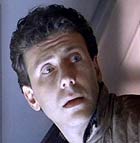(Originally posted July 12, 2008)
First, I want to clarify one thing: When I’m talking about “monster” here, I’m talking about the fictional archetype appearing in literature, cinema, video games, comic books, television, fairy tales and myths, works of art, etc. I am definitely not trying to define a”real-life monster.” Ted Bundy was definitely a”monster” in the generic since – he was certainly more terrifying, depraved, and destructive than many fictional monsters – but he’s not the kind I’m interested in writing about. This is important for my next line of thought, which was inspired by comments that made me start thinking about the difference between a “villain” and a “monster” (again,the fictional archetypes…). Though I believe that a monster can (and often is) a villain, and villains can sometimes be monsters, I think there is a distinction between the two and being one doesn’t ensure the other…
Because it’s easier than opening a book, I returned to Wikipedia, which defines “monster” as “any of a large number of legendary creatures which usually appear in mythology, legend, and horror fiction…” and as “a gross exception to the norms of some ecosystem… Usually characterized by an ability to destroy human life or humanity…” Wikipedia defines a “villain” as: “an ‘evil‘ character in a story, whether an historical narrative or, especially, a work of fiction. The villain usually is the bad guy, the character who fights against the hero…”
Even the most basic Freshman lit courses teach us that a villain has a very specific role infiction: to oppose the hero. A beginning screenwriting course will teach you that you need conflict to tell a good story, and the most recognizable form of conflict occurs when you have two “characters” with opposing goals – a hero and his villain. Through this conflict, we learn something about ourselves and the human condition. Given this definition, many monsters are also “villains”: Ripley’s goal is survival, but the alien wants to eat her (though I’d point out that The Company and Ash are much more sinister villains…); Reese wants to protect Sarah Connor, but the Terminator wants to kill her; Chief Brody wants to make the beaches safe, and the shark wants to eat anyone swimming in the ocean (the mayor is also a villain standing in the way of Chief Brody’s goal).
So, if a “villain” has a specific role, what is the monster’s role in fiction and art? How does it teach us something about ourselves and the human condition? Again, I’d suggest that the monster’s role is to confront us with primal and universal fears (Criteria #1 in previous posts). The most successful monster stories dig deep into our psyches to draw out fears that can challenge, unsettle,warn, or inpsire us. We are confronted by things we didn’t even know we feared (the fear that one day our kids will turn on us like they do in The Brood and Frankenstein); hard and sad truths that we will hopefully strive to overcome (we fear other races as much as the flesh-eating zombies in Night of the Living Dead); and things we should fear but don’t actually respect enough (science in Frankenstein and The Fly, or atomic power in Them!).
 In this last incarnation, monsters continue to serve as powerful cautionary figures, just as they do in folk tales: don’t go into the woods alone; don’t play god; take care of the planet and don’t piss off Mother Nature; keep your hubris in check; be responsible and don’t let that Jason kid drown in the lake while you’re off having a good time; and just don’t be a jackass to your fellow man because, although bad things can happen to good people, the jackasses always get it worse in the end.
In this last incarnation, monsters continue to serve as powerful cautionary figures, just as they do in folk tales: don’t go into the woods alone; don’t play god; take care of the planet and don’t piss off Mother Nature; keep your hubris in check; be responsible and don’t let that Jason kid drown in the lake while you’re off having a good time; and just don’t be a jackass to your fellow man because, although bad things can happen to good people, the jackasses always get it worse in the end.
In reviewing the criteria oultined previously, I had thought to adda #4 dealing with presentation and/or appearance, something along the lines of: “Monsters are generally uncanny in appearance or behavior, setting them apart from humans and/or others of their kind.” Some of the most memorable monsters have physical traits that remind us of the fears they embody: the stitches on Frankenstein’s Monster remind us that he was pieced together from dead bodies; the Alien seems to wear his bones on the outside, resembling a skeleton and reminding us that it’s a walking death machine; Leatherface wears a bloody apron and a skin mask to remind us that we are just prey to be butchered and bled like animals, eaten, and even worn (plus, he’s deformed underthe mask). I can think of very few monsters who don’t have this trait.Even Hannibal Lecter has his creepy stare.
But, the longer these lists get, the more there is to parse… Thoughts?

Leave a Comment